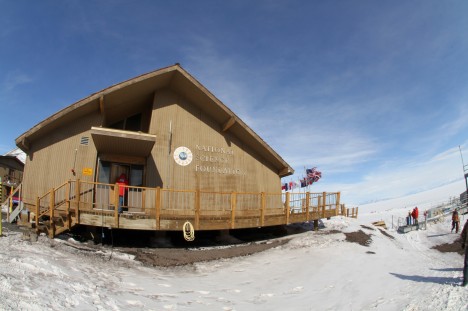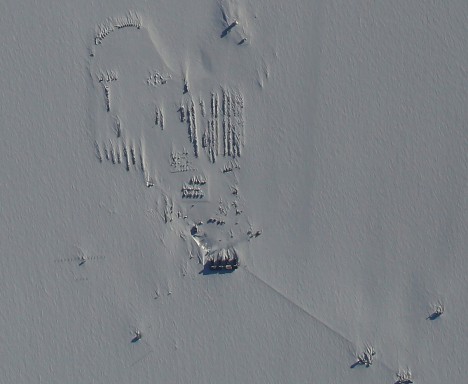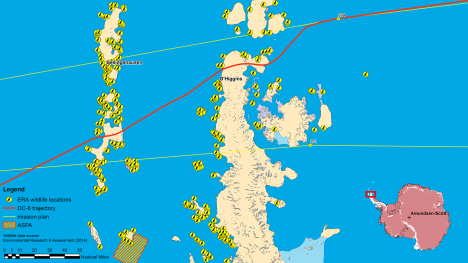Antarctica is one of the most inaccessible places on Earth. Yet in spite of this, it is highly vulnerable to human impacts. This vulnerability along with the pristine nature of much of Antarctica is what has motivated a number of protective regulations, many of which IceBridge personnel have to keep in mind every day.
The use of Antarctica is governed by an international agreement known as the Antarctic Treaty, which was signed by 13 nations in 1961. The Antarctic Treaty sets the continent and surrounding ocean aside for peaceful purposes like scientific research. Over the years more nations signed the treaty and more protocols regarding things like environmental protection were added to it.

The National Science Foundation Chalet, an administrative building at McMurdo Station in Antarctica. To the right of the building are flags representing the 13 nations that originally signed the Antarctic Treaty. Credit: NASA / Jefferson Beck
All over the continent are regions known as Antarctic Protected Areas. These fall into three categories, Antarctic Specially Protected Areas (ASPA), Antarctic Specially Managed Areas (ASMA), and Historic Sites or Monuments (HSM). When IceBridge plans its Antarctic flights these environmental protections and restrictions around known wildlife habitats come into play. The areas surrounding McMurdo Station, where IceBridge was based last year, are full of protected areas and wildlife sites. On some occasions as soon as the NASA P-3 took off the team had to maneuver their way around restricted areas.
Clearing the Air
On the DC-8 the time between takeoff and encountering a protected area is longer simply because of the distance between Punta Arenas and Antarctica. But there were two flights that took the DC-8 over a large managed area at the South Pole.

An overhead view of Amundsen-Scott Station at the South Pole captured by the Digital Mapping System cameras aboard the NASA DC-8. Credit: NASA / DMS Team
South Pole Station is the site of a large ASMA that covers just over 26,000 square kilometers and places limits on ground and air travel and the use of certain electronics. One particular portion is known as the Clean Air Sector, a wedge-shaped region that extends 150 kilometers out and 2000 meters above the surface. To comply with the ASMA rules at the South Pole, the DC-8 had to pass over at high altitude and had to shut down laser and radar instruments to avoid causing interference with scientific gear on the ground.
Wildlife Protection
While large ASMAs like that at the South Pole are a factor on a few flights, IceBridge has to keep a watchful eye out for wildlife locations on each flight in Antarctica. Penguins, seals and other animals in Antarctica could be disturbed by overflying aircraft, therefore planes have to stay a minimum distance away and above known wildlife locations, though IceBridge keeps an extra margin of safety by staying farther away.
After a campaign is complete, officials with the National Science Foundation go over each survey’s flight path, checking the mission’s flight plans to make sure no wildlife protection rules were violated.

Map showing the NASA DC-8 flight path and wildlife locations on part of the Antarctic Peninsula. Credit: NASA
To ensure that the plane keeps a safe distance, IceBridge uses its sophisticated navigation equipment and a detailed map of places where animals live in and around Antarctica. Prior to each flight, mission planners discuss wildlife locations with pilots and navigators and remain in continual contact with the plane’s flight station about these sites.
Studying Antarctica whether on the surface or in the air means that you’re going to have some sort of impact. The data gathered by researchers in Antarctica is valuable to improving our understanding of the world, so the best option we have is to minimize that impact. And with proper training and a good dose of care from teams working in Antarctica, scientists can learn about it while still preserving it.
For more about Antarctic Protected Areas, visit: http://www.ats.aq/e/ep_protected.htm
For more about the South Pole Station ASMA, visit: http://www.southpole.aq/management/zones.html
Tags: Antarctic 2014





Con el descongelamiento de la plataforma que rodea la Antártida, sobre todo en las áreas de corrientes de glaciares en las sub-capas de la plataforma, donde el agua más pesada es más cálida, me gustaría tener una idea en porcentajes del grado de inserción mineral y el nivel de agua fosilizada que se esta incorporando a la circulación de corrientes que circunvalan el Polo Sur. HRG